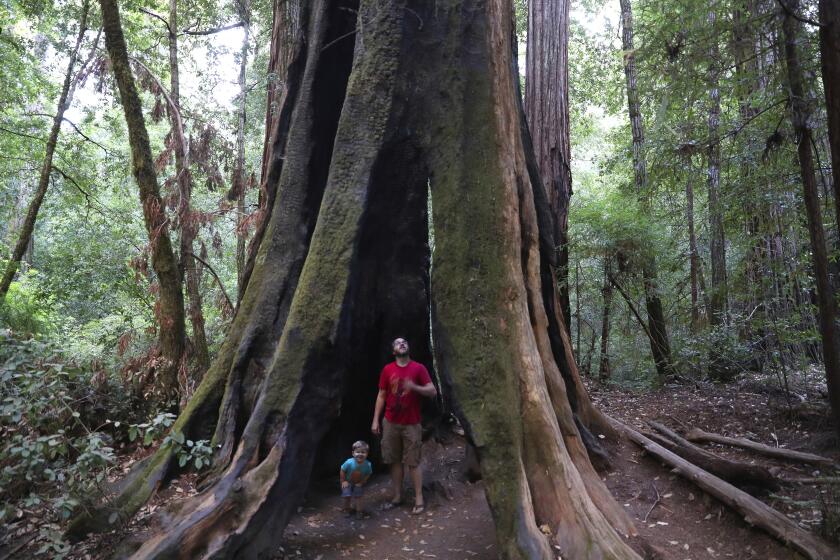UC Santa Cruz evacuates amid fires; students urged to shelter at the beach
- Share via
A raging and unpredictable complex of wildfires forced authorities Thursday to order the evacuation of UC Santa Cruz, one of the few times students and faculty at a top California learning institution have been forced to flee from flames.
State and local authorities ordered the campus to evacuate late in the day after previously warning that evacuations might be necessary.
Scotts Valley, a hub of Santa Cruz County’s tech industry, was also ordered to evacuate, with some residents heading down to the Santa Cruz boardwalk, a refuge from the blazes.
“All on-campus residents must evacuate now and be prepared to not return for at least two weeks,” UC Santa Cruz said in a tweet. “The evacuation center for UCSC is in Coconut Grove at the Boardwalk.”
The mascot of UC Santa Cruz is the banana slug, a creature that thrives in cool, wet forests. Santa Cruz has been anything but lately, and the flames from the CZU August Lightning Complex fire threaten to overwhelm the campus and possibly push down into Santa Cruz, a city of 64,000.
More than 18,000 students are enrolled at UC Santa Cruz, although it is unclear how many were physically on campus or in Santa Cruz before the evacuation order. The university is working with local hotels to find rooms for students forced to flee.
As of Friday morning, the CZU August Lightning Complex fire was 0% contained, according to Cal Fire. It had spread to more than 50,000 acres, was threatening more than 20,000 structures and had forced the evacuations of roughly 64,000 people. It has destroyed historic structures in Big Basin Redwoods State Park and is jumping across rugged terrain amid a pandemic and multiple fires in Northern California that have challenged fire crews.
California’s oldest state park has suffered extensive damage from the C.Z.U. August Lightning Complex fires.
As of late Thursday, more than 700,000 acres have burned in Northern and Central California.
Firefighters called the fires hitting San Mateo and Santa Cruz counties the largest in recent memory.
“It’s a historic event. This fire is historic for an area like San Mateo-Santa Cruz. We have not seen fires burn like this in this unit, in either one of these counties, for many, many years. And those fires were much smaller than what we have in front of us today,” said Ian Larkin, unit chief for Cal Fire’s San Mateo Santa Cruz Unit.
Billy See, a Cal Fire incident commander, said the fire grew fast on Thursday — from 700 to 1,000 acres an hour in heavy timber.
“That’s a dangerous rate of spread,” See said.
“We need to be cognizant that we are in historic times in this fire that we’re dealing with here on the coastline. It’s a dangerous situation for everyone involved,” See said. While more resources and more manpower are arriving, “it’s still not enough. We’re still drastically short for a fire this size.”
See said the return of the cool, humid marine layer would help, but there’s still some concern about the forecast for winds of 10-20 mph on ridge tops. There will still be low humidities overnight, he said.
“This country likes to burn at night, moreso than during the day. And that’s because of the wind patterns. The winds aloft will lower down, and clear out the smoke, which will then increase the fire rate of spread through the vegetation out there,” See said.
“It’s all based on terrain, weather conditions and fuels conditions. And the fuels conditions right now are very poor, just because of the drought conditions.”
Officials said Thursday night that the fire was encroaching into the San Mateo County communities of Pescadero and Loma Mar.
The Santa Cruz County community of Davenport was still threatened, although fire was subsiding on the coastline.The fire has moved down to Highway 9 near the mountainous community of Ben Lomond, which is also close to the communities of Boulder Creek and Felton.
Firefighters were in that area protecting structures. San Mateo County has issued evacuation orders for the towns of Pescadero, San Gregorio and La Honda.
The National Weather Service on Thursday night said low pressure was nudging into the area, bringing cooler temperatures and higher humidities.
The smoke plume associated with the fire was blanketing most of the Central Coast in smoke, “with the plume stretching nearly 600 miles offshore,” the weather service said.
“Smoke continues to be trapped over the region owing to a strong decoupling of the lower and free atmosphere, resulting in poor air quality conditions,” the weather service said.
More to Read
Sign up for Essential California
The most important California stories and recommendations in your inbox every morning.
You may occasionally receive promotional content from the Los Angeles Times.












